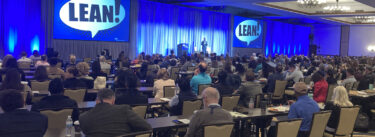Articles
Learn more about your selected topics.

2024 Lean Summit Panel — The Promise of AI in Healthcare and How Lean Thinking Can Realize Its Potential
Watch a panel discussion from the 2024 Lean Summit on how the combination of AI and lean thinking is revolutionizing…
Watch video
Teaching Lean Thinking to Kids: A Conversation with Alan Goodman
Learn how Alan Goodman uses games and hands-on activities to teach lean concepts to middle schoolers and nurture critical thinkers…
Listen to podcast
2024 Lean Summit Recap
LEI's Lean Summit showcased how leaders leverage lean for innovation from AI-powered healthcare to US manufacturing's revival.
Read article
Hardware Meets Software: Lean and Agile Lessons for Innovation
Our latest webinar features LEI Senior Advisor, Jim Morgan, and co-founder and CTO of software group Theodo, Fabrice Bernhard. They…
Watch webinar
The State of US Manufacturing and Its Role in Innovation: a Conversation with Ben Armstrong and Jim Morgan
Ben Armstrong and Jim Morgan explore America’s industrial past, assess its present, and discuss the challenges and opportunities that lie…
Listen to podcast
Nine Tips to Better Process Development
Achieve exceptional results with your next product launch. Master nine proven techniques for designing successful, waste-free processes.
Read article
Whatever Happened to Quality First: Rethinking Product Development in the Wake of Recalls and Catastrophic Failures
This Design Brief tackles the often-overlooked topic of building quality into new products. Learn how a customer-centric approach in development…
Read article
Quality Leadership at the Forefront of Innovation: A Conversation with Jeri Ford of Lucid Motors
Lucid Motors’ Vice President of Quality, Jeri Ford, shares lessons from the automotive industry on how to build a culture…
Listen to podcast
From Concept to Perfection: Toyota’s GD3 Method Sets a New Standard in Product Quality
The innovative GD3 method can help you rethink product development to improve customer satisfaction, boost cost-effectiveness, avoid recalls, and prevent…
Read article
Operations IS Your Customer
Discover how redefining operations as the primary customer of engineering can transform product development, enhance collaboration, and drive unprecedented improvements…
Read article
Developing 35,000 Problem Solvers: OhioHealth’s Journey in Lean Healthcare with Alli Kulp and Emily Swaney
How one large healthcare system is developing problem-solving skills across 35,000 employees through standardized lean processes, daily huddles, and leadership…
Listen to podcast
Software’s Quality Leap: Three Lessons from Toyota’s Dantotsu Approach to Reduce Defects at Scale at Theodo
Bridging the gap between manufacturing and software, Theodo cofounder and CTO Fabrice Bernhard, explains the company’s transformative journey of applying…
Read article